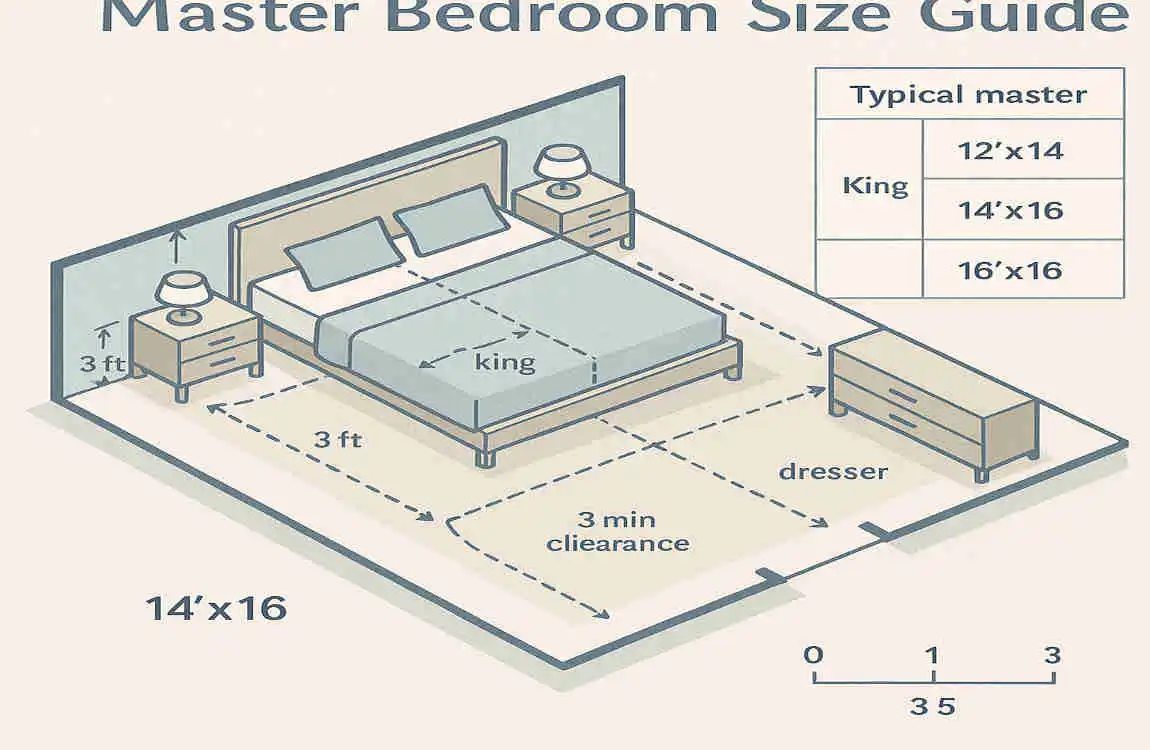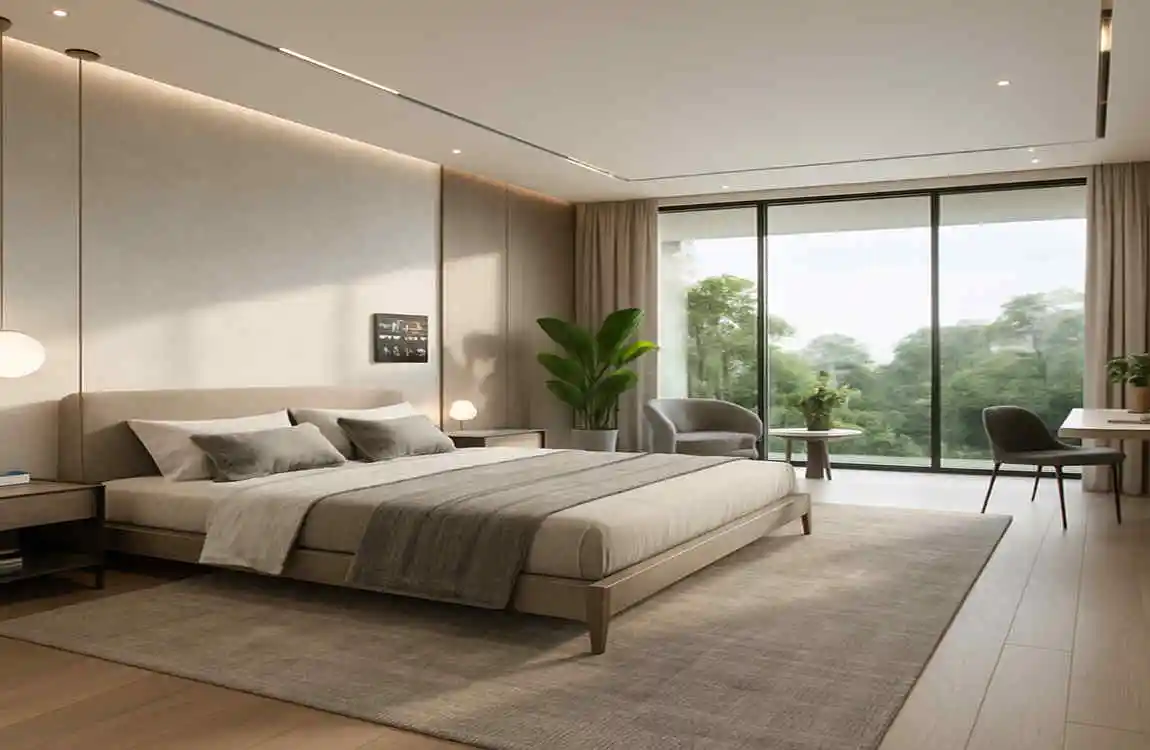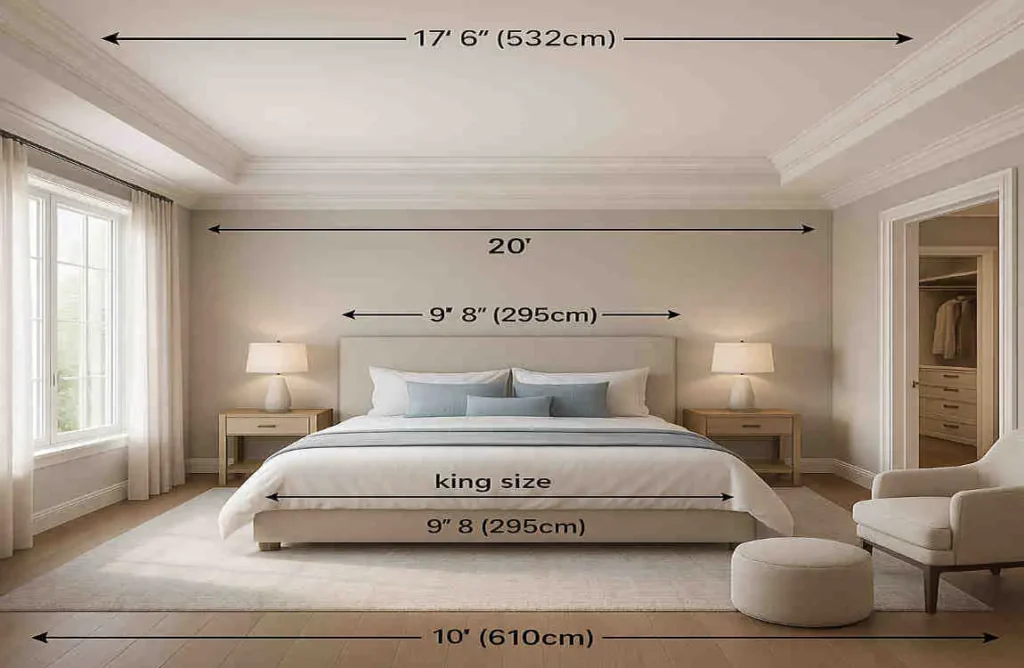Imagine walking into your home after a long day and being greeted by a serene, spacious main bedroom that feels like a personal retreat. The main bedroom is more than just a place to sleep; it’s a sanctuary where you can unwind, relax, and recharge. But have you ever wondered what a typical main bedroom size is for a spacious house?
The size of your main bedroom matters for several reasons. A well-sized room can enhance your comfort, improve the functionality of the space, and even increase the overall value of your home. Whether you’re building a new house or renovating an existing one, understanding the typical main bedroom size is crucial for creating a space that meets your needs and desires.
Understanding Master Bedroom Size Basics

What Defines a Main Bedroom?
Before we delve into the specifics of master bedroom sizes, let’s clarify what exactly constitutes a main bedroom. A main bedroom is typically the largest bedroom in a home, often reserved for the primary residents. It’s designed to be a private oasis, offering more space and amenities compared to other bedrooms in the house.
Factors Influencing Main Bedroom Size
Several design considerations can influence the size of a main bedroom. Comfort is paramount; you want a space that feels relaxing and inviting. Storage is another crucial factor, as you’ll need room for closets, dressers, and other storage solutions. The overall layout of the room also plays a role, as you’ll want to ensure there’s enough space for furniture arrangement and easy movement.
Typical Main Bedroom Size Ranges
Master bedroom sizes can vary depending on the type of home and its overall size. In smaller homes, a typical main bedroom might range from 12×12 feet to 14×14 feet. Mid-sized homes may have master bedrooms measuring around 14×16 feet or 16×18 feet. For spacious houses, the typical main bedroom size often falls within the range of 16×20 feet or larger.
Home Size: Typical Master Bedroom Size
Small 12×12 ft to 14×14 ft
Mid-Size 14×16 ft to 16×18 ft
Spacious 16×20 ft or larger
Average Main Bedroom Sizes
In the United States, the average main bedroom size is around 300 to 400 square feet. However, this can vary depending on factors such as the region, the age of the home, and the overall design style. Globally, main bedroom sizes can differ significantly based on cultural preferences and building standards.
- In the U.S., the average main bedroom size is 300-400 sq ft
- In the U.K., the average is slightly smaller at 250-350 sq ft
- In Australia, master bedrooms tend to be larger, averaging 350-450 sq ft
What Is a Typical Main Bedroom Size for a Spacious House?
Defining a Spacious Main Bedroom
Now that we’ve covered the basics, let’s focus on what constitutes a typical main bedroom size for a spacious house. A spacious main bedroom offers ample room for relaxation, storage, and additional amenities. It’s a space where you can truly spread out and enjoy your personal retreat.
Size Ranges for Spacious Master Bedrooms
In a spacious house, the typical main bedroom size often starts at around 14×16 feet and can go up to 16×20 feet or larger. These dimensions provide plenty of room for a king-size bed, nightstands, dressers, and even a sitting area or workspace. Some luxury homes may feature master bedrooms that exceed 20×20 feet, offering an expansive and indulgent space.
- 14×16 ft: A comfortable size for a spacious main bedroom
- 16×20 ft: Offers ample room for a king bed and additional furniture
- 20×20 ft or larger: Ideal for luxury homes with expansive master suites
The Impact of Ceiling Height and Layout
When determining the typical main bedroom size for a spacious house, it’s essential to consider not just the floor area but also the ceiling height and overall layout. Higher ceilings can create a sense of grandeur and openness, making the room feel even more spacious. Additionally, a well-designed layout that maximizes the use of space can enhance the overall perception of size.
Case Studies: Spacious Master Bedrooms in Action
To give you a better idea of what a typical main bedroom size looks like in a spacious house, let’s explore a couple of case studies:
The Coastal Retreat
In this luxurious coastal home, the main bedroom measures 18×22 feet. The room features a king-size bed, a cozy sitting area with a fireplace, and a large walk-in closet. The high ceilings and large windows create an airy, open feel that enhances the spaciousness of the room.
The Modern Oasis
This contemporary home boasts a main bedroom that spans 20×24 feet. The sleek design incorporates a king bed, a spacious dressing area, and a dedicated workspace. The open floor plan and minimalist decor contribute to the sense of spaciousness, making the room feel even larger than its actual size.
How to plan Your Main Bedroom Size for Maximum Comfort
Factors Impacting Size Decisions
When planning your main bedroom size, several factors come into play. You’ll need to consider the size and placement of your furniture, the amount of walking space you desire, and the inclusion of features like closets and en-suite bathrooms. Balancing these elements is crucial for creating a comfortable and functional space.
Minimum Square Footage Recommendations
To ensure you have enough room for your essential furniture, consider the following minimum square footage recommendations:
- King-size bed: 120 sq ft (including nightstands)
- Queen-size bed: 100 sq ft (including nightstands)
- Dresser: 20-30 sq ft
- Armoire or wardrobe: 20-30 sq ft
- Sitting area: 50-75 sq ft
Balancing Size and Functionality
While a larger main bedroom can offer more flexibility, it’s essential to strike a balance between size and functionality. Consider your lifestyle and needs when planning the size of your space. If you enjoy reading or working in your bedroom, allocate space for a dedicated seating area or workspace. On the other hand, if storage is a priority, you might opt for a larger closet or dressing area.
Optimizing Smaller Spaces
If you’re working with a smaller main bedroom, don’t worry! There are several design tricks you can use to make the space feel more spacious:
- Lighting: Use plenty of natural and artificial light to brighten up the room and create a sense of openness.
- Mirrors: Strategically placed mirrors can reflect light and create the illusion of more space.
- Layout: Opt for a layout that maximizes the use of space, such as placing the bed against a wall or using multi-functional furniture.
Planning Tools and Software
To help you visualize and plan your main bedroom size, consider using design software or online tools. Programs like SketchUp, Room Sketcher, or even simple floor plan apps can help you experiment with different layouts and sizes before making any final decisions.
Additional Features Affecting Main Bedroom Size
Walk-in Closets
One of the most coveted features in a main bedroom is a walk-in closet. These spacious storage areas can significantly impact the overall size of your main suite. Depending on your needs, a walk-in closet can range from 50 to 200 square feet or more. When planning your main bedroom size, be sure to account for the space required for your dream closet.
En-suite Bathrooms
An en-suite bathroom is another common feature in master bedrooms. The size and design of your bathroom will also influence the overall dimensions of your suite. A small en-suite can measure around 50-75 square feet, while a more luxurious bathroom with a separate shower and bathtub requires 100-150 square feet or more.
Additional Amenities
Spacious master bedrooms often include additional amenities that can impact the overall size of the space. These may include:
- Dressing areas: A dedicated space for getting ready, typically requiring 30-50 square feet
- Fireplaces: A cozy addition that can add 10-20 square feet to the room
- Sitting rooms: A separate area for relaxation, often measuring 75-100 square feet
- Balconies: An outdoor space that can add 50-100 square feet or more to the overall size
Smart Storage Solutions
To maximize the usable space in your main bedroom, consider incorporating innovative storage solutions. Built-in closets, under-bed storage, and multi-functional furniture can help you make the most of every square foot. By optimizing your storage, you can create a more spacious and organized main bedroom.
Master Bedroom Size Trends for 2025 and Beyond

Multi-functional Master Suites
As we look to the future, one of the most significant trends in main bedroom design is the shift toward multi-functional spaces. In spacious homes, master suites are increasingly being designed to serve multiple purposes beyond just sleeping. These versatile rooms may include dedicated workspaces, exercise areas, or even small kitchenettes for added convenience.
Integration of Smart Home Features
Another trend that’s impacting main bedroom sizes is the integration of smart home features and technology. From automated lighting and climate control to voice-activated assistants and entertainment systems, these modern amenities can influence the layout and size of your main suite. As you plan your space, consider how you can incorporate these features to enhance your comfort and convenience.
Eco-friendly Design
In recent years, there has been a growing emphasis on eco-friendly design in home construction and renovation. This trend is also affecting main bedroom sizes and layouts. Sustainable materials, energy-efficient windows, and passive design principles can all impact the dimensions and overall design of your main suite. By prioritizing eco-friendly choices, you can create a spacious and environmentally conscious retreat.
Common Mistakes to Avoid When Planning a Master Bedroom Size
Oversizing or Under sizing the Room
One of the most common mistakes when planning a main bedroom is either oversizing or undersizing the room. An oversized room can feel cold and impersonal, while an undersized room can feel cramped and claustrophobic. Strike a balance by considering your needs and the overall size of your home when determining the appropriate dimensions for your main suite.
Ignoring Natural Light and Ventilation
Another mistake to avoid is neglecting the importance of natural light and ventilation in your main bedroom. A spacious room can feel dark and stuffy if it lacks proper windows and airflow. When planning your main suite, prioritize windows that allow ample natural light and consider the placement of your bed and furniture to maximize the benefits of these elements.
Poor Furniture Planning and Flow
Improper furniture planning and layout can also detract from the overall feel of your main bedroom. A spacious room can quickly feel cluttered and cramped if the furniture is arranged inefficiently. Take the time to carefully plan your furniture placement, ensuring there’s enough walking space and a logical flow throughout the room.
Not Considering Future Needs or Resale Value
Finally, don’t forget to consider your future needs and the potential resale value of your home when planning your main bedroom size. While it’s essential to create a space that meets your current requirements, think about how your needs may change over time. Additionally, a well-designed and appropriately sized main suite can be a significant selling point when it comes time to put your home on the market.
